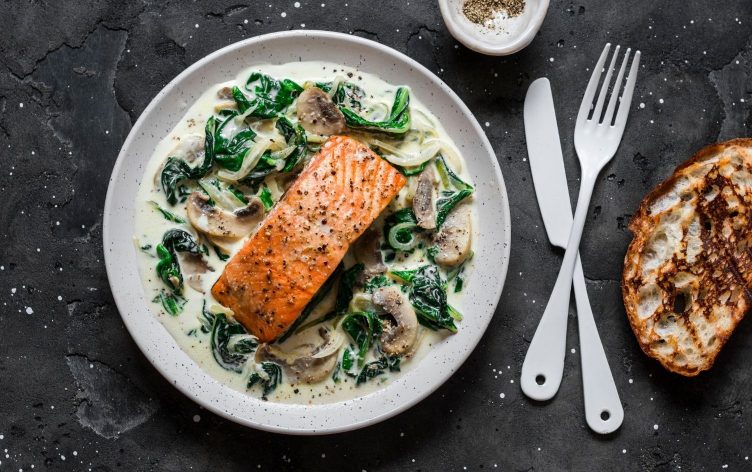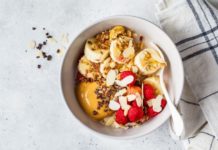
Forget Salads: Ways to Get Your (Warm) Greens In
Yes, yes, it’s undeniable salads are a light, fresh and “clean” way to get in all of those beautiful vegetables that nutrify, mineralize and supercharge your body. But during the cold months of winter, Ayurvedic medicine provides a lot of reasons not to eat salads — especially if you’ve got big fitness, health and weight-loss goals. Why stray away from salads through these cold winter months?
THREE REASONS TO SKIP THE FRESH SALADS
1. OUR BODIES NEED SEASONAL INGREDIENTS TO SUPPORT HEALTH
Seasonal ingredients are those that are growing on our farms right now. Nature is really cool, and it provides what living beings need in the times they need it. The apples are ripe for deer to eat just as they’re building their winter coats. The grains are ready to be squirreled away just in time for squirrels to start their winter slumber. And, if we want to feel good in our bodies, and achieve our fitness goals, we’ll align with these same natural rhythms and eat the foods that are available in winter. These are the foods that have the most nutrients, minerals and the greatest bioavailability in the cold, and the foods that will help us look and feel our best. Light, delicate leafy greens are nowhere to be found in winter. Instead, root vegetables, squash, potatoes and hearty winter greens are the easiest to find — and these deep, leafy greens must be cooked to be digested properly.
2. KEEP THINGS MOVING SMOOTHLY
Ayurvedic medicine reminds us the healthy, nourishing foods we eat only benefit our bodies if we digest and assimilate them properly. And, for most of us, salads — particularly those made with hearty, deep leafy greens are very challenging (if not almost impossible) to digest, especially in cold weather. And so, they go in one end and out the other — literally. Fiber is an important part of gut and digestive health, and an important component in digestion and elimination, but cooking our greens doesn’t actually diminish any of that healthy dietary fiber, and it makes the greens easier to digest. Cooking salads is a win-win.
3. STAYING WARM IS A WIN FOR HEALTH, FITNESS AND WEIGHT GOALS
Our bodies are working hard through the winter simply to stay warm and execute basic functions, not to mention to help us fulfill our busy lives as parents, professionals, and people in general. Then, we add in fitness and weight-loss goals. We can make all of these targets easier for our bodies to hit by consuming warm foods in the cold winter months. Everything we eat and drink needs to be warmed up to 98°F before it’s digested. And while it may seem that giving your body extra work to do would mean burning extra calories, the opposite is true: the more work of this type that your body has to do, the less likely it is to absorb and utilize those healthy meals, and the more likely we are to miss our goals, gain weight in the winter and feel sluggish come spring.
Cooking greens, and eating warm salads is a perfect way to maximize our intake of powerful, potent, plant-based nutrition and to make it easy for our bodies to break down, assimilate and benefit from the nutrients we’re eating. Here are a few smart ways to get cooking.
IT’S EASY EATING GREEN
1. SAUCE THEM UP
Cooking your greens and then blending them into a creamy sauce to stir into noodles, grains or serve with eggs and more is a smart, simple way of getting your greens in an easy-to-digest, delicious way. These Green Miso-Coconut Noodles are a great example:
Green Miso-Coconut Noodles
Serves 4
Ingredients
- 1 1-inch (2.5cm) knob of ginger, peeled and diced
- 4 cups (120 grams) spinach greens, washed and trimmed of stems
- 2 cups (60 grams) mixed herbs (cilantro, chervil, parsley, dill)
- 3 scallions, chopped
- 1 tablespoon white miso paste
- 2 teaspoons tahini, well-stirred
- 1 cup (250ml) whole-fat coconut milk
- Juice and zest of 1 lime
- 1/2 teaspoon flaky sea salt, plus more to taste
- Freshly cracked black pepper, to taste
- 1 tablespoon ghee
- 10-ounces ramen noodles (can use 2-5 ounce packages)
- 1/4 cup (32 grams) unsweetened shredded coconut
- 2 tablespoons black sesame seeds, white sesame seeds or hemp seeds
Directions
Bring a medium pot of water to a boil.
In a small skillet, toast the shredded coconut, watching very carefully so the coconut doesn’t burn, until fragrant and golden.
Meanwhile, in the bowl of a food processor or a high-speed blender, purée the spinach, cilantro, miso, tahini, scallions, coconut milk, lime juice, a pinch of flaky salt, a few cracks of pepper until the smooth and very green. Taste, adjust the salt and pepper if you wish, then set aside.
When the water is boiling, cook noodles according to package directions. Then, drain, but don’t rinse, and return them to the pot. Add the ghee to the noodles and top with the spinach coconut sauce. Toss the noodles until they’re well coated with sauce, then divide between bowls.
Top with toasted coconut, sesame seeds and serve!
Hint: Your miso-coconut sauce can be made 1 day ahead. Cover and refrigerate. The color may darken slightly, but your sauce will still be great.
2. SAUTE THEM INTO WARM GRAINS
Short on time, or searching for a really simple way to enjoy a salad in winter? Saute greens with a bit of healthy fat into grains to make yourself a warm, veggie-forward grain bowl. To try it yourself:
Warm 1/2 tablespoon ghee or olive oil in a large skillet over medium-high heat. Add 1 cup of cooked grains, such as rice or quinoa, a pinch of sea salt, a couple of cracks of pepper and 2 large handfuls baby spinach or baby kale. Stir to combine. Add 1/3 cup vegetable of chicken broth or water and saute until the greens wilt, the grains warm through and the liquid has evaporated completely, 2–3 minutes. Transfer the grains and greens to a bowl, top with your favorite protein.
3. ROAST THEM WITH THE REST OF YOUR INGREDIENTS
This sheet pan method is a great way to make yourself a hearty cooked salad, without too much fuss. Add greens tossed in dressing to a warm oven, and they wilt into a lovely, nourishing meal.
Sheet Pan Chicken With Squash Salad, Roasted Halloumi and Warm Greens
Serves 4
Ingredients
- 2 cloves garlic, divided
- Zest and juice of 1 small lemon
- 3 tablespoons olive oil, divided
- 1 1/2 teaspoons kosher salt, divided
- Freshly ground black pepper, to taste
- 3–4 boneless skinless chicken breasts
- 1 medium delicata squash
- 6 ounces (170 grams) Halloumi cheese, cut into 1-inch (2.5cm) cubes
- 2 teaspoons ground cumin
- 4 shallots, thinly sliced
- 1 tablespoon Dijon mustard
- 2 tablespoons tahini, well-stirred
- 1/2 tablespoon pure maple syrup
- 1 large bunch kale, ribs and stems removed, leaves chopped
Directions
Place a rack in the upper third of the oven; preheat to 425° (218ºC). Finely grate one clove of garlic into a large bowl. Mix in lemon zest, 2 tablespoons oil, 2 teaspoons kosher salt and season with pepper. Pat the chicken dry and place in the bowl, turning and rubbing with the lemon-garlic mixture to evenly coat.
Cut the squash in half lengthwise; scoop out the seeds and discard. Slice crosswise 1-inch (2.5cm) thick. Place squash and Halloumi on one half of a large rimmed baking sheet. Drizzle 1 tablespoon oil over the top, finely grate remaining garlic on top, and sprinkle with cumin and 1 teaspoon kosher salt. Season with pepper and toss to combine. Arrange into an even layer, keeping to the same side.
Place shallot slices in 6 piles on the other half of the baking sheet; top each pile with a chicken breast, skin side up. Roast until chicken is cooked through and squash is fork-tender, 25–30 minutes.
Meanwhile, whisk together lemon juice, mustard, syrup, tahini, remaining 1/2 teaspoon kosher salt; season with pepper. Add cool water by the tablespoon to thin the dressing to a pourable consistency. Add the kale, and massage the dressing into the greens.
Turn the broiler to high, and move the squash and halloumi to the middle of the sheet pan, making space for the greens. Transfer the greens to the sheet pan in the oven with the chicken and squash and allow to wilt, roast and warm for 5–7 minutes, then pull the sheet pan from the oven.
Transfer chicken to a cutting board; thinly slice. Transfer to a bowl with the roasted greens, and add the squash, halloumi and shallots. Season with pepper and enjoy.
4. GET DOWN ON NEW GREENS
Salads — cooked or raw — aren’t the only way to get in your greens. Winter vegetables like Brussel sprouts and brassicas are super sources of vitamins and minerals, and they’re green vegetables that are easy to cook, easy to digest and powerful for our bodies.
THE BOTTOM LINE
Cold salads are superfoods for our bodies and our fitness goals, in the spring and summer. But in the winter, our bodies want (and need) warm, easy-to-digest, nutrient-rich plan foods to power us to success. Skip the raw salads and cook your greens for best results!
































